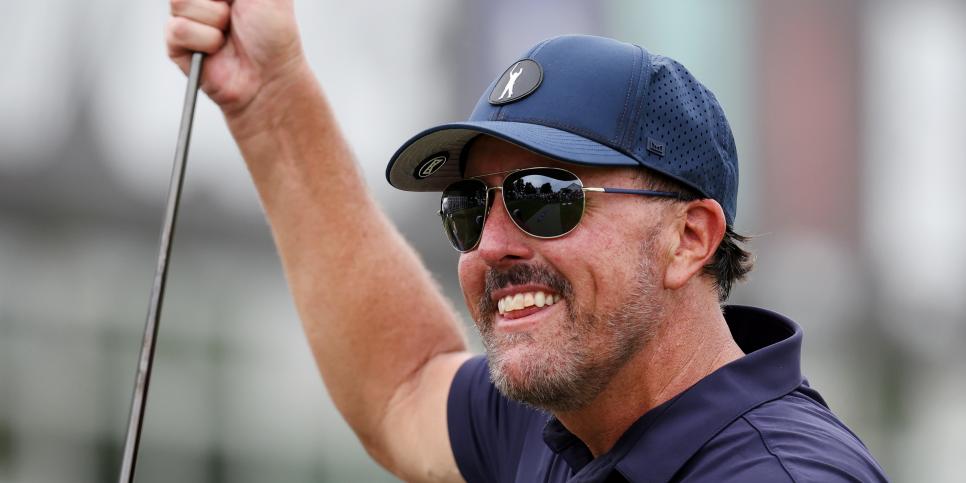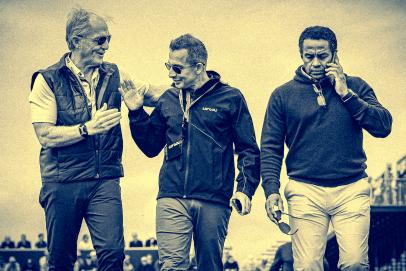Editor's Note: This article first appeared in Fire Pit Collective, a Golf Digest content partner.
ATLANTA — Phil was right.
Of course, Monsieur Mickelson went about things in entirely the wrong way, which is typical of a complex, contradictory character who so often has been his own worst enemy. Now that his former place of business, the PGA Tour, has undergone a sweeping transformation in an effort to thwart the upstart competitor he championed, it is time to reassess Mickelson’s legacy as an agent of change.
The tumultuous events of the past two weeks have provided some sweet vindication for Phil. As he laid out for me in a freighted phone call in November 2021, Mickelson has long believed that PGA Tour players need to have more say in how they are governed. That is exactly what has transpired, as Tiger Woods and Rory McIlroy have emerged as de facto co-commissioners. Cementing the players’ new muscle is the remaking of the tour’s all-powerful board of directors, as it has been expanded from nine seats to 10, with the players being given a fifth representative; no longer are they outnumbered by bureaucrats and businessmen.
As Jon Rahm told me this week at the Tour Championship, “As players, we have been told [by tour leadership] a million and a half times, You are the PGA Tour. And I think recently might be the first time I feel like they actually care about what players think.”
The mini-uprising led by Woods and McIlroy has forced changes to the schedule in an effort to get the best players competing against each other more often. This has also been a longtime Mickelson talking point: He is an outspoken critic of opposite-field events, believing they water down the tour’s product, and as Brandel Chamblee told me about being paired with Phil at the B.C. Open in the 1990s, “Knowing that I was on the Player Advisory Council, he spent the whole time in my ear saying the PGA Tour should be reduced to only the top 30 players—nothing but the stars. He was totally oblivious to the fact that would eliminate my job.”
Mickelson was seduced by LIV Golf’s fantastical money because he has long nursed the grievance that, as the second biggest star of the past quarter-century, he was vastly underpaid. (Whether he was compelled to take the Saudis’ money because of what he has since called a gambling addiction is a question that is explored in detail in my recently published biography.) In our phone conversation, Mickelson noted that his on-course earnings peaked in 2009 at $8.3 million, including the FedEx Cup bonus, a fraction of what top players earn in team sports. What particularly bothered Mickelson was his suspicion that the PGA Tour was not giving the players a fair share of the revenue. He cited the tour had cash reserves of $800 million, an exaggerated number that hinted at the truth. Faced with the LIV threat, the tour has suddenly opened the spigot of new TV money. The nebulous Player Impact Program was created out of thin air to funnel money to the top players, and in less than a year the pot has ballooned from paying 10 players $40 million to distributing a whopping $100 million among 20 players. (One of the tour’s strongest differentiators was as a pure meritocracy versus LIV’s potentially corrupting guaranteed money, but the PIP now offers lavish compensation that is not tied to on-course performance.) Hasty increases in purses and additional bonus programs put another another $95 million in the pockets of PGA Tour players in 2022, and now the Tour has committed to a slate of a dozen mega-tournaments with $20 million purses, more than double what many of these events paid out this year. Asked on Wednesday where all this fresh money would come from, commissioner Jay Monahan said existing tournament sponsors will help defray the costs, but he also cited the primary source of this new largesse: “Reserves.” Phil was right.
He was also obsessed with how players could better monetize their their name-image-likeness, particularly through NFTs. Voíla, the PGA Tour announced this spring a program to peddle NFTs for its players, though details remain nebulous. (NFTs of LIV golfers are already for sale.) Mickelson railed against the tour for charging him a $1 million licensing fee to compete in made-for-TV exhibitions, part of what he called a pattern of stifling the players’ ability to market themselves outside of the traditional confines. Now, in the new world order, the tour is happily supplying its stars for a series of Monday night indoor team exhibitions, in a fledgling enterprise called TGL, which is owned by Woods and McIlroy.

Charles Laberge/LIV Golf
It’s impossible to say how many of these changes would have come about without Mickelson’s brinkmanship, but he undoubtedly played a crucial role. Millions of new dollars will flow to the game’s best players in the next few years, but Mickelson is getting, at best, grudging acknowledgement. As McIlroy said this week, “As much as I probably don’t want to give Phil any sort of credit at all, yeah, there were certain points that he was trying to make. Some of these ideas, did they have merit? Of course they did.”
The lingering bitterness toward Mickelson—not just from players but also fans and other stakeholders in the game—is less about what he did than how he did it, particularly the sneakiness. He was conducting stealthy negotiations with Monahan while at the same time secretly helping the Saudis organize LIV. Acting as a double agent inevitably leaves both sides with the gnawing suspicion that the two-timer is only out for himself; in McIlroy’s formulation, it was “a renegade group trying to take some sort of power grab of the PGA Tour.” Rory and Tiger have taken the exact opposite tact of Mickelson’s self-serving approach. These new guardians of the Tour have solicited consensus and fostered solidarity, galvanizing the other players to work together for the greater good. (This approach inevitably benefits the individuals too.) McIlroy and Woods have been hailed for their leadership, and their standing in the game has only been further solidified.
It was only 15 months ago that Mickelson, at the age of 51, won the PGA Championship in the crowning moment of a legendary career. As he was enveloped in a delirious crush of fans on the final fairway of the Ocean Course, one of golf’s most enduringly popular players had never been more beloved. But behind the scenes, forces were already in motion that would forever cloud his legacy and turn him into a pariah on the tour that made him a star. Mickelson has earned a nine-figure bonanza from LIV and helped reshape the landscape of professional golf. But it is impossible not to wonder if, in his quiet moments, he still believes this fight was worth it.



